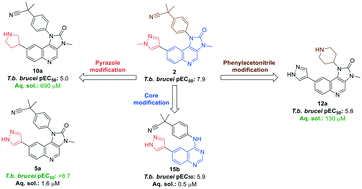Structure–property studies of an imidazoquinoline chemotype with antitrypanosomal activity†
Abstract
Human African trypanosomiasis is a neglected tropical disease (NTD) that is fatal if left untreated. Although approximately 13 million people live in moderate- to high-risk areas for infection, current treatments are plagued by problems with safety, efficacy, and emerging resistance. In an effort to fill the drug development pipeline for HAT, we have expanded previous work exploring the chemotype represented by the compound NEU-1090, with a particular focus on improvement of absorption, distribution, metabolism and elimination (ADME) properties. These efforts resulted in several compounds with substantially improved aqueous solubility, although these modifications typically resulted in a loss of trypanosomal activity. We herein report the results of our investigation into the antiparasitic activity, toxicity, and ADME properties of this class of compounds in the interest of informing the NTD drug discovery community and avoiding duplication of effort.

- This article is part of the themed collection: Neglected Tropical Diseases


 Please wait while we load your content...
Please wait while we load your content...